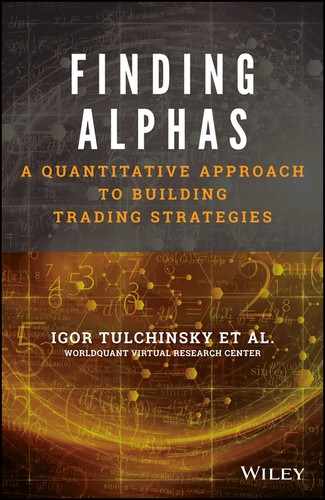25
Alpha on Currency Forwards and Futures
By Richard Williams
Finding alpha within the currencies and futures markets is an area of great practical interest. It also presents many challenges, as has already been noted in this book. In this chapter we will discuss some of the techniques and habits of thought that have been useful in attacking this problem over the last few years.
KEY MARKET FEATURES
Futures, in particular, are designed to give the trader exposure to price changes in the underlying market without necessarily having to fund owning the equivalent position in the underlying asset. Within the context of alpha research, short dated forwards on currencies provide the same sort of framework for accessing relative currency value. This means that futures and forwards are extremely convenient instruments for both hedgers and speculators, and give rise to probably the most significant feature we want to consider.
UNDERLYING FACTOR EXPOSURE
Since both futures and forwards give exposure equivalent to the underlying, it follows that the factors affecting the underlying assets are the ones that drive the price of the future/forward. This simple observation has important implications: there are distinct groups of market traders who are focused on particular groups of futures and currencies; these are the hedgers looking to control their risks to particular factors. Good examples are provided by the commodity futures, where producers and consumers of physical commodities hedge their risk on specific commodities. For example, the farmers and food producing corporations that use the agricultural markets extensively to control their risks have little in common with the airlines who make extensive use of energy futures to hedge their future fuel costs. Each group of traders can have their own characteristic risk limits, tolerances, and trading behaviors, which in turn can give rise to qualitatively different market behavior.
In recognition of these differences between market users, it is traditional within many organizations to have specialists managing the trading of different classes of futures and currencies, with the classes based on grouping sets of similar, underlying assets. This further reinforces the differences between “sectors,” as different traders, desks, and business lines are all managing different futures and forwards.
CONSEQUENCES OF INSTRUMENT GROUPING
The instrument groups discussed above give us both opportunities and challenges in seeking alpha. One of the most obvious challenges is that, as we consider smaller groups of more closely-connected instruments, we have fewer things we can actually trade. Therefore, we require stronger structure per instrument than we do to achieve the same aggregate results with a larger instrument set. As the quality of the per-instrument alpha increases, it becomes more obvious to other market participants and its expected lifetime is reduced. Conversely, as we identify sets of similar instruments, we have greater expectations that any particular alpha should be present across the whole set. The test of deleting each instrument in turn, and retesting the identified relationship, becomes more meaningful. These instrument groups often become the basic units on which we test our alpha candidates.
BASIC CHECKLIST FOR ALPHA TESTING
We start from the core alpha idea; the first step is to identify the sectors where we expect it to appear, and the timescales on which we expect it to manifest. As an example, let us consider the US energy market and an alpha based on the forecast of extreme weather in a major offshore US oil and gas field. Before we even consider the data, we can identify the instruments we expect to be relevant – oil, gas, and their products – and the timescale we expect the data to have an impact on, in this case including how long a typical storm lasts and how long it takes to stop and restart production (there will be a range of views on both of these horizons, but we can still use the implied causal relationship between the extreme weather and the commodity supply to narrow the range of candidates). We can now test the claim by getting the historic weather forecasts and price changes for the major energy contracts, and test for association between the two datasets, using a partial in-sample historic dataset.
The next step is to fit a simple, statistical model and test robustness, as well as varying parameters in the fit. One good robustness test is to include a similar asset where we expect the effect to be less strong. In the case of our example above, Brent crude oil would be a reasonable choice. Crude oil is a global market, so we would expect some spillover from a US supply disruption. However, oil delivered in Europe is not a perfect substitute for the US supply, so we would expect a diluted impact. Again, we can test this with in-sample data.
Having investigated where we would expect the alpha to work, we can now test the converse: Where do we expect there to be no relationship? In the case of our example, it is quite closely targeted to one sector so we would expect to detect no relationship if we retested in different sectors such as industrial metals or bond futures. This step is surprisingly good at finding incorrectly coded or specified statistical tests.
Depending on the results of the above, we could now be in a position to test our idea on our own out-of-sample dataset. With such a small set of instruments, the out-of-sample test becomes a crucial part of the process, helping to avoid unintentional overfitting.
SUMMARY
The grouping of instruments into sectors based on the underlying asset is important, with both common and distinct groups of market actors across and within these sectors providing a mechanical connection between these instruments. If you take a moment to consider how the factor exposure of each sector should respond to the idea you are exploring, you will find a useful place to start testing your ideas.
